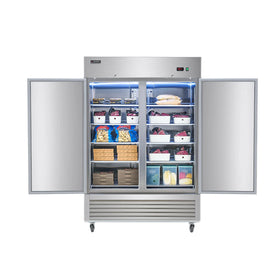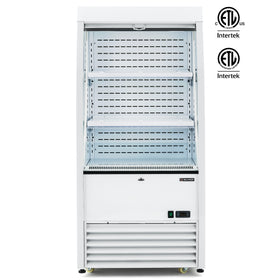The kitchen equipment needed to set up a school kitchen is slightly different from that needed for outfitting a restaurant or a small café. With school kitchen equipment, the focus is on volume, safety, nutrition, and efficiency, feeding as many students as possible in a short window of time.
The exact school kitchen equipment you need depends on whether you’re running a full-service production kitchen (cooking meals from scratch) or a finishing/serving kitchen (reheating and serving pre-prepared meals).
But in general, here’s a breakdown of the core school kitchen equipment you’ll need:
- Cooking equipment
- Refrigeration and freezing equipment
- Food preparation equipment
- Holding and serving equipment
- Dishwashing and Sanitation
- Smallwares and utensils
- Storage equipment

1. School Kitchen Cooking Equipment
Cooking equipment is a crucial part of school kitchen equipment. Schools often need kitchen equipment that can handle bulk cooking while meeting nutritional guidelines. Here are six essential cooking equipment you need for a school kitchen:
i. Convection ovens
A school kitchen needs a convection oven because it cooks food faster and more evenly than a conventional oven. A convection oven comes with a fan that circulates hot air, making it ideal for baking, roasting, and cooking large batches of food. This is important when preparing meals for many students at once.
Convection ovens are also better at maintaining consistent quality and temperature, which reduces cooking time and increases kitchen efficiency.
It is a practical equipment for high-volume school kitchen meal production.
ii. Combination ovens
A combination oven is another essential piece of school kitchen equipment. It offers multiple cooking modes (steaming, convection, etc) in one unit. This versatility helps cook large batches quickly and handle a large variety of foods like vegetables, meats, and baked goods efficiently.
iii. Steamers
Steamers are important in a school kitchen because they help cook large quantities of food quickly using steam. Steaming retains nutrients, color, and texture, especially for vegetables and rice.
They are energy-efficient, reduce cooking time, and allow staff to prepare healthy meals in bulk while keeping them moist and visually appealing.
Commercial ranges and commercial griddles
Commercial ranges and griddles are essential in a school kitchen: they provide versatile, high-volume stovetop cooking surfaces for pancakes, eggs, and other quick items.
- A commercial range can be used to boil, sauté, simmer, and cook multiple pots at once, which is critical for soups, sauces, and pasta in large batches.
- A commercial griddle offers a flat, even surface for cooking foods like pancakes, eggs, sandwiches, and burgers quickly and consistently.
Together, both range and griddle will speed up meal prep in a school kitchen, handle large quantities, and support a variety of menu items.

2. Essential School Kitchen Refrigeration and Freezing Equipment
Refrigeration and freezing equipment cover all the school kitchen equipment needed to keep ingredients safe and organized. Here are three major refrigeration and freezing equipment you need in a school kitchen:
Walk-in coolers and freezers
- Walk-in coolers are essential for a school kitchen because they are designed for storing bulk produce, dairy, and even frozen items.
- These are all products that school kitchens typically purchase in bulk and need to be kept for long-term usage.
Reach-in refrigerators/freezers
- A school kitchen needs reach-in refrigerators for storing ingredients in a safe but accessible way. Commercial reach-in refrigerators have an upright design that maximizes storage in a compact footprint.
- They also have multiple shelves that allow for organized bulk storage of dairy, produce, and prepped items, helping staff work efficiently during busy meal service.
Milk coolers and Display Coolers.
Milk coolers and commercial display refrigerators are essential in a school kitchen where you might want to serve cartons or bottles of milk to students, especially during breakfast.
3. School Kitchen Food Preparation Equipment
In a school kitchen, you need to handle prep efficiently and safely. For this, you need the right food preparation equipment.
Commercial mixers
Commercial mixers are essential for handling large batches of dough, batter, or other mixtures quickly and consistently. They save time and reduce manual labor, and also ensure that the baked goods, mashed potatoes, sauces, and other recipes are of a uniform texture and quality.
Food processors/slicers
Food processors are ideal in a school kitchen for chopping, slicing, and shredding produce and cheese in bulk. They are essential in a school kitchen that serves sandwiches, pizzas, tacos, nachos, etc
Work tables and cutting boards
Together, both work tables and cutting boards ensure streamlined, hygienic prep in a school kitchen.
- Work tables are essential for assembling, chopping, mixing, and portioning ingredients efficiently.
- Cutting boards protect both the table and knives and help prevent cross-contamination when handling different food types.
Portion scales
Portion scales are used in school kitchens to ensure consistent serving sizes for meals, which helps maintain nutritional standards, control food costs, and reduce waste.

4. Holding and Serving Equipment For School Kitchens
Since school lunches are served in short timeframes, keeping food hot or cold is critical. For that, you need the following school kitchen equipment:
- Hot holding cabinets: To keep the cooked food at safe temperatures for serving.
- Cold holding units/salad bars: For fruit, salads, and grab-and-go items.
- Serving lines: For steam tables, cold wells, or combo lines where students get their meals.
5. Dishwashing and Sanitation Equipment for School Kitchens
Health and safety are top priorities in a school kitchen. Here are some of the most essential kitchen equipment you need:
- Dishwashers: Could be high-capacity, conveyor, or flight type, but must be capable of handling trays, dishes, and utensils.
- Three-compartment sinks: These are required by most health codes for washing, rinsing, and sanitizing when a dishwasher isn’t suitable.
- Handwashing sinks: These are to be placed in convenient locations for staff in order to preserve hygiene standards.
- Grease traps and floor drains: For sanitation and compliance.
6. Essential School Kitchen Smallwares and Utensils
Some types of commercial kitchen equipment are often overlooked, but are absolutely essential. Consider the following:
- Sheet pans, stock pots, hotel pans: For bulk cooking and serving.
- Ladles, tongs, spatulas, and serving spoons are sized for portion control.
- Commercial Knives and peelers.
- Measuring cups and portion scoops to ensure consistency.
- Cafeteria trays and serving utensils are durable and easy to clean.
7. School Kitchen Storage Equipment
- Dry storage shelving for canned and packaged goods.
- Ingredient bins for flour, rice, pasta, etc.
- Secure chemical storage for cleaning supplies, separate from food.
8. Safety and Compliance Equipment For School Kitchens
- Fire suppression system (hood system). These are required for the cooking equipment.
- First aid kits, PPE, and cut-resistant gloves.
- Thermometers, handheld probes, and built-in monitoring systems.
Many schools use combi ovens, tilting skillets, and steamers as their “workhorses” since they’re versatile, speed up cooking, and help prepare healthier meals.

Final Thoughts on School Kitchen Equipment
This blog covers the core equipment most school kitchens require, whether you’re outfitting an elementary school or a large high school cafeteria. From here, you can adjust based on whether your program focuses more on scratch cooking, heat-and-serve meals, or grab-and-go service.
For your pasteries and baked products, here are some tips on how to buy the best commercial dough mixer in 2025










